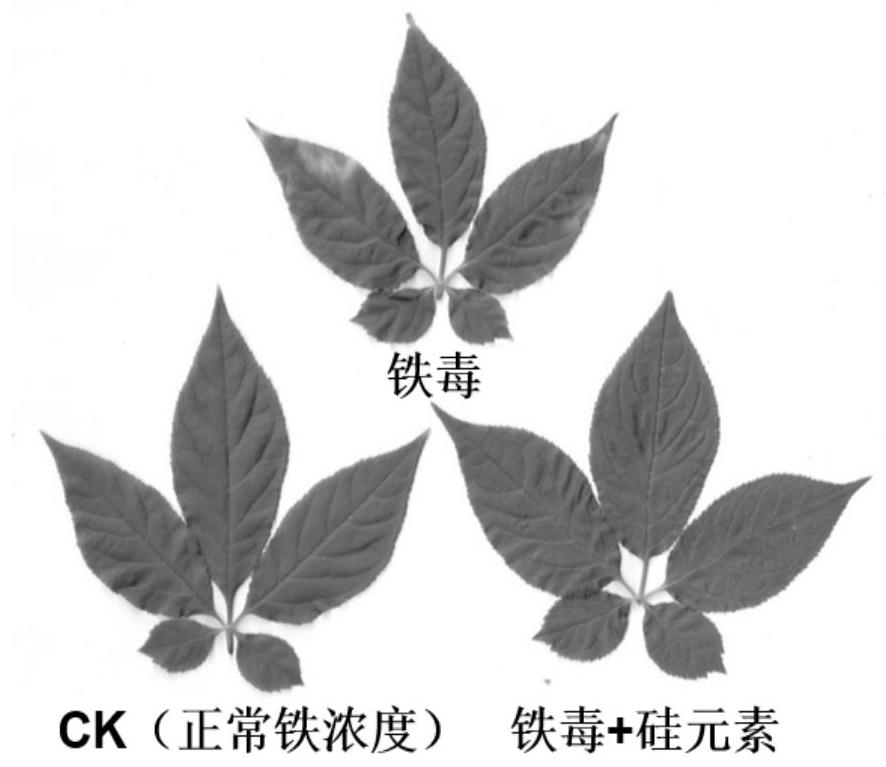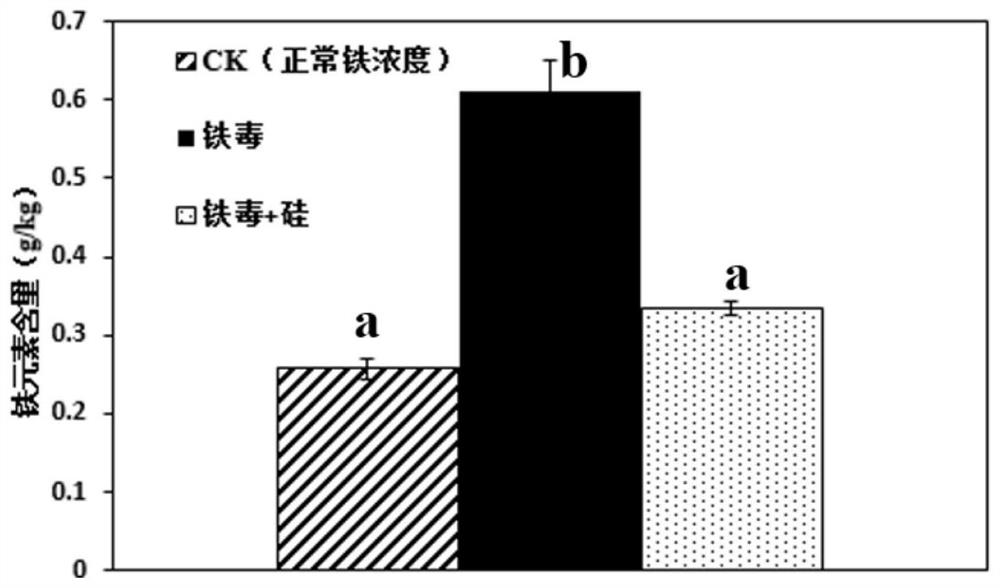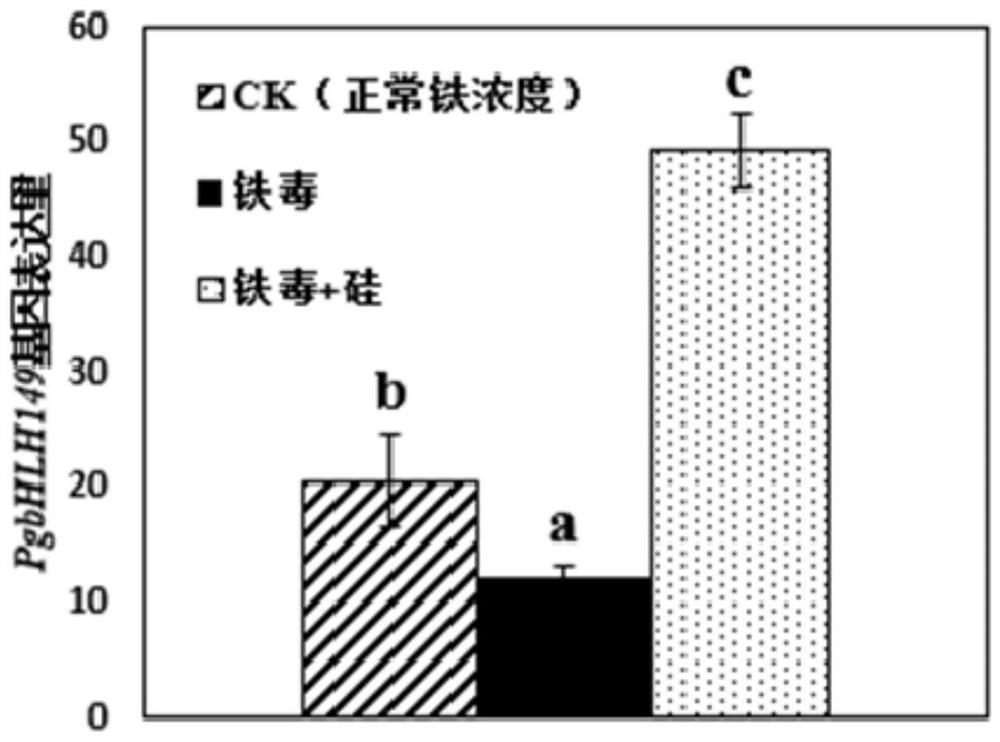Ginseng PgbHLH149 transcription factor and application thereof
A technology of pgbhlh149 and transcription factors, applied in the fields of application, genetic engineering, plant gene improvement, etc., can solve problems that restrict the health and sustainable development of the ginseng industry, economic losses, and affect the economic benefits of ginseng planting, etc.
- Summary
- Abstract
- Description
- Claims
- Application Information
AI Technical Summary
Problems solved by technology
Method used
Image
Examples
Embodiment 1
[0051] Example 1 Screening of ginseng iron toxicity-related transcription factor gene PgbHLH149
[0052] The ginseng seedlings were treated with 0.05mM Fe (normal iron concentration), 0.4mM Fe (iron toxicity stress), 0.4mM Fe+Si (0.5mM, 1.5mM, 2.0mM) respectively, and the effective screening for relieving the iron toxicity stress of ginseng was screened. Exogenous substances and their appropriate concentrations, it was found that adding an appropriate amount of silicon (0.5mM) under iron toxicity stress can effectively alleviate the symptoms of iron toxicity in ginseng (see figure 1 and figure 2 ).
[0053] Tissues such as ginseng roots, stems and leaves under different iron treatment conditions were taken, and part of the experimental samples were quick-frozen in liquid nitrogen and stored at -80°C for RNA extraction. Another part of the samples were dried in an oven at 105°C for 30 minutes, and dried at 80°C to constant weight for elemental composition analysis.
[0054]...
Embodiment 2
[0063] Example 2 Cloning and sequencing of ginseng iron toxicity-related transcription factor gene—PgbHLH149 gene
[0064] Since the PgbHLH149 gene sequence information provided by the transcriptome analysis results may not be 100% accurate, the inventors of the present application re-amplified and sequenced the PgbHLH149 gene: using ginseng cDNA as a template, the PgbHLH149 gene sequence was divided into multiple small fragments for amplification. In addition, the sequences of multiple small fragments are designed to overlap and overlap at the beginning and end, and the multiple small fragments are sequenced separately. After the sequencing results are spliced, the complete sequence of the PgbHLH149 gene is obtained.
[0065] The extracted ginseng total RNA was synthesized into cDNA using M-MuLV First Strand cDNA Synthesis Kit M-MuLV First Strand cDNA Synthesis Kit, and used as a template for PCR amplification. Design multiple pairs of primers for amplifying the full-length c...
Embodiment 3
[0085] Example 3 PgbHLH149 gene transfer into Arabidopsis test
[0086] Vector construction experiment:
[0087] 1. Primer design:
[0088] bHLH149-F:AGAACACGGGGGACGAGCTCATGGTATCATTATTTATCTCGAATCCCGA
[0089] bHLH149-R:CCATGGTGTCGACTCTAGAGGATCCTAAAGTCGATGATTGGGATAAATTTGAGC
[0090] 2. Target gene amplification PCR reaction system:
[0091] reaction system Usage amount 2×fast pfu master mix 10.0μl Primer bHLH149-F 1μl Primer bHLH149-R 1μl cDNA 1μl wxya 2 o
up to 20μl
[0092] Reaction program: 94°C: 3min; 94°C: 30sec; 58°C: 45sec; 72°C: 1kb / 30s; 33cycles; 72°C: 10min; 16°C: forever.
[0093] A small fragment (PgbHLH149 gene fragment) was recovered.
[0094] 3. The target gene is connected to the target vector:
[0095] PgbHLH149 gene overexpression vector construction scheme, the map of the PgbHLH149 gene overexpression vector see Figure 5 .
[0096] (1) Digest plasmid pCAMBIA2300-GFP with SacI and BamHI to recover...
PUM
 Login to View More
Login to View More Abstract
Description
Claims
Application Information
 Login to View More
Login to View More - R&D
- Intellectual Property
- Life Sciences
- Materials
- Tech Scout
- Unparalleled Data Quality
- Higher Quality Content
- 60% Fewer Hallucinations
Browse by: Latest US Patents, China's latest patents, Technical Efficacy Thesaurus, Application Domain, Technology Topic, Popular Technical Reports.
© 2025 PatSnap. All rights reserved.Legal|Privacy policy|Modern Slavery Act Transparency Statement|Sitemap|About US| Contact US: help@patsnap.com



